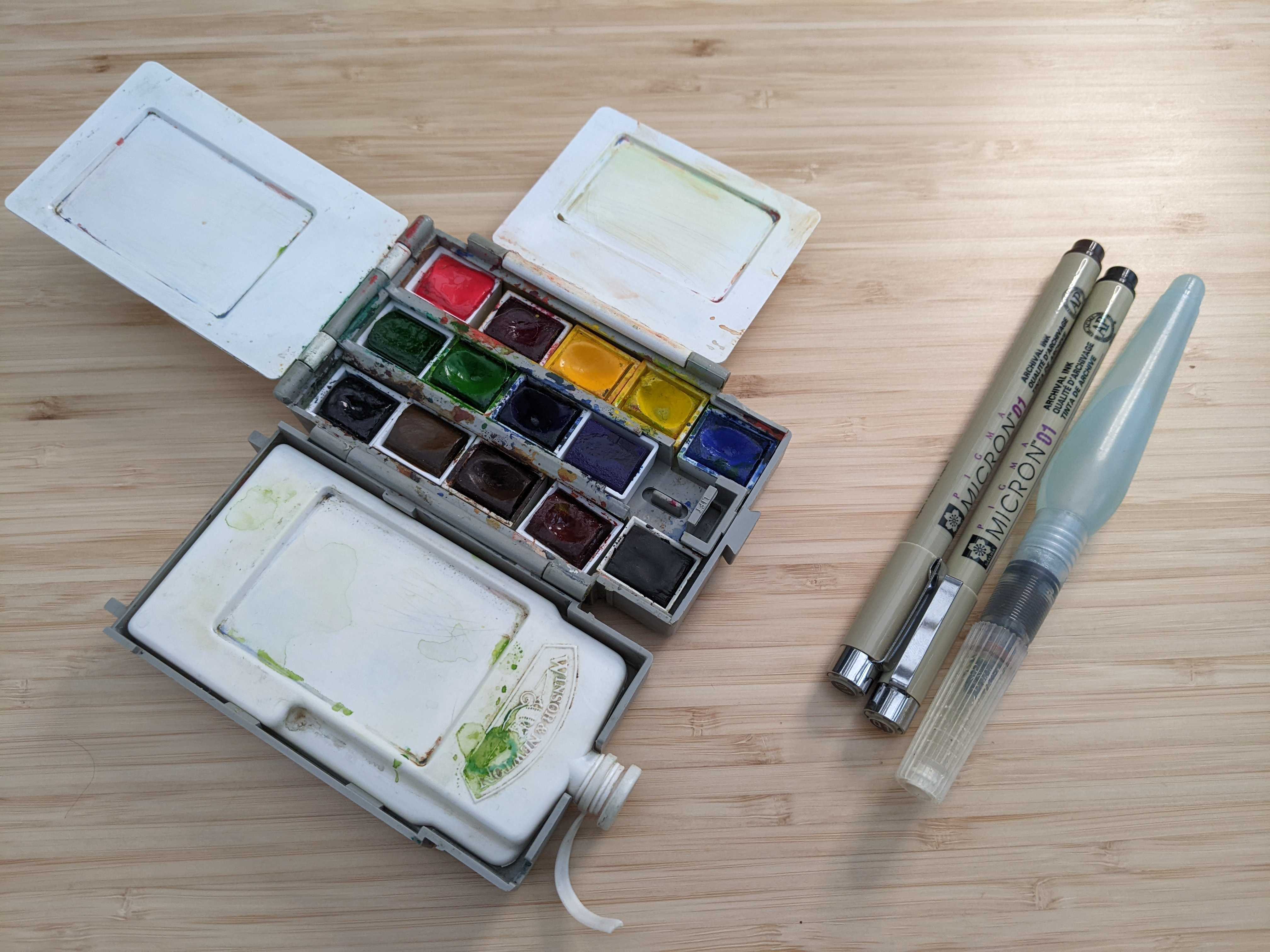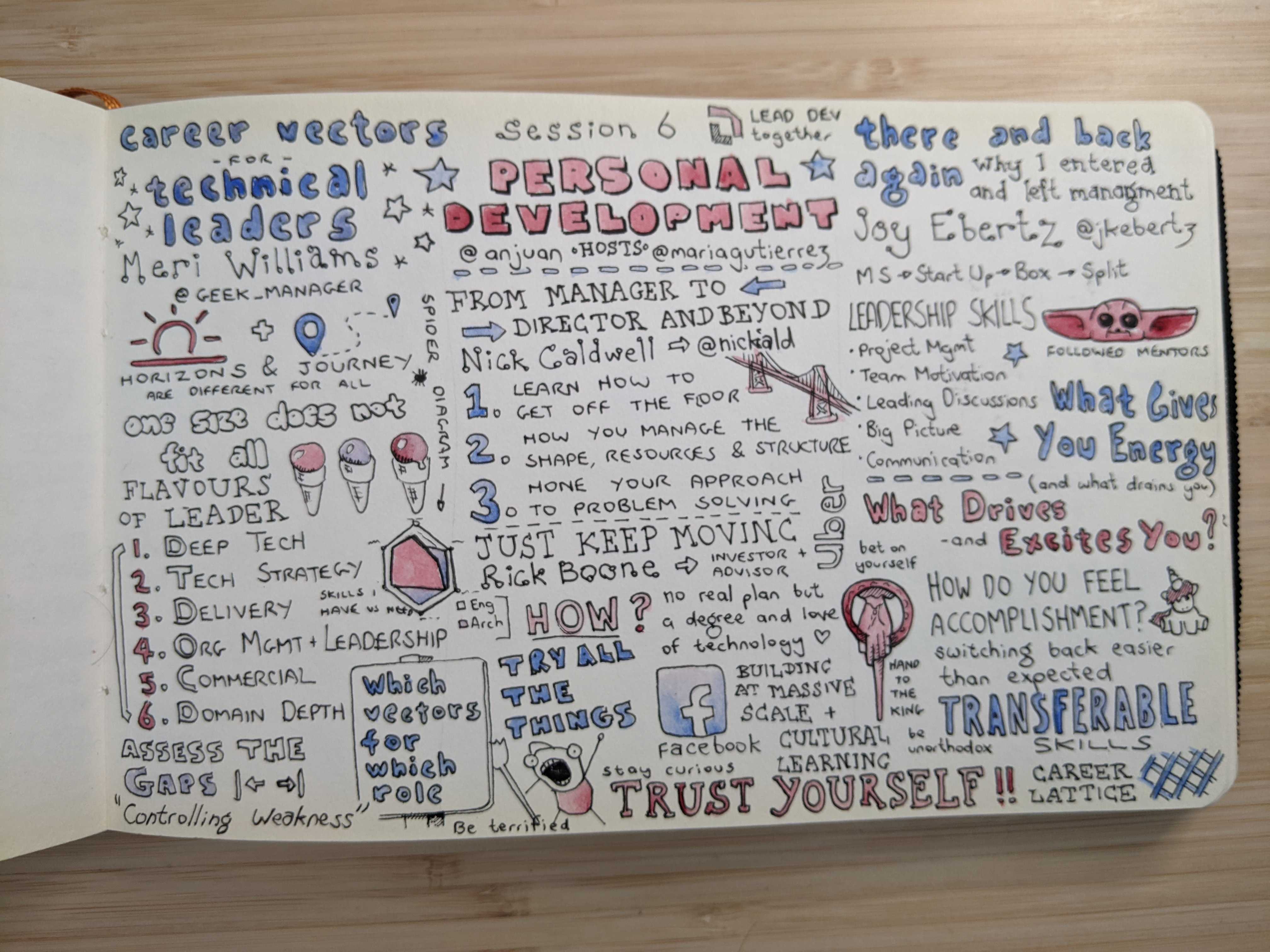Sketch Notes
Andy Polhill
People who follow me on Twitter will see the occasional flurry of sketch notes that appear when I attend a conference. Having returned from such a conference I was inspired to write a post on the subject.

Sketch noting isn't something that I set out to learn. I have always doodled, if you add structure and a bit more detail, sketch notes are an obvious progression. There isn't a strict definition of what is and isn't a sketch note. My own definition of a sketchnote would be something like the following.
Sketching a combination of type and imagery in live response to an audio and/or visual stimulus
A fancy way of saying sketching while someone else talks. The live aspect is important for me. It's one thing sketching at your own pace, it's a very different thing when you don't control the variables. Having constraints can be quite refreshing and help break through any creative block. In this case the time and content are the constraints.

Why write sketch notes?
It helps me to focus: Anyone who happens to watch me sketch might be wondering how much attention I am paying. Although I'm not looking at the speaker much I am actively listening. Doodling has been proven to improve memory and focus, which means I get the most of the talk.
Reference: Although sketching helps my memory retention I will still sometimes forget things. The good news is that I now have a written reference that I can look back at. I keep all of my sketch notes in one book, which makes it a useful reference. If I remember a concept but not the name of it, I can look back and at the very least find the name of the person I learnt it from.
It's fun: Sketching is good fun, it's therapeutic and relaxing. I like the notion of content creation as well as content consumption. At the end of any talk I will have a memento of my day which was fun to make.
Exposure: I don't have any shame in admitting this. During conferences I will often tweet my sketch notes. Partly because I hope it will be useful to others, but also for the exposure. Some of my most interacted tweets are the ones with sketch notes and that feedback feels good.
Equipment
I like to travel light when it comes to sketching equipment. Everyone has their own tailored setup, this is mine.


Sketchbook
I'm not sure how I acquired the sketchbook I use for sketch notes. Somewhere along the way I adopted an existing sketchbook and I've used it ever since. The book in question is landscape format, 90mm x 150mm with white 80gsm paper. I'm not a paper nerd, but this book suites the purpose well. It's not too big for transporting around or using in confined spaces. More importantly, I can fit notes from a 40 minute to 1 hour on the page size. I do sometimes use watercolour to provide a bit of pop. The 80gsm paper holds up well with lightweight colouring.
Pens
It took me a while to find the best pen to suit my style. I've settled upon the 01 Pigma Micron. Normally in black but I did pick up some sepia coloured ones which give a softer look. I like the thin nib which gives my notes a busy flat look. The Pigma Micron has archival ink and doesn't bleed when painted over. For a while I carried pens with different nibs and alternated depending on how prominent I wanted text to appear. This was a bit of a faff as I was having to constantly switch between pens, and the result wasn't much better. I don't bring any pencils as there is rarely enough time to use pencils first.
Watercolours
My watercolour setup could do with a bit of a work for sketch notes. I have a 12 colour portable set which is tailored for urban sketching or still life, It's quite a subdued palette. For sketch notes I pick two contrasting colours, ideally bright ones. If I was setting up from scratch I would probably use a smaller 6 or 8 set tin. I use half pans instead of tubes as they are easy to access and less messy. Watercolours vary in transparency. I always try and find transparent ones when working on top of ink otherwise it washes out the ink.
Brush Pens
To apply the watercolours I use brush pens. Brush pens contain a water vessel in the handle, the water feeds the brush providing a constant flow. Brush pens are great for working quickly. There is no need for bringing additional water which could also spill. I only bring one pen with me and I use the finest brush possible, I rarely need to cover any big spaces. I bring kitchen roll which is crucial for cleaning the brush between colour changes. The kitchen roll is useful for soaking soak up any excess water from the brush pen.
Process
I have a couple of different processes that I follow when sketchnoting.
Radial
In this approach I start by writing the title and the speaker in the centre. I try and use some bigger blockier font for this to help it stand out. I like to get this part looking good and I'll generally work on this during the introduction. With the title in place I then work around the page in a clockwise fashion starting at the top. I'm not strict on any order, if it's a busy sketch I'll finish by squeezing words into any remaining space.

Columns
I start by writing the title and speaker at the top of the page. Similar to the radial approach I'll try and make this the most prominent thing on the page. I then split the page into 3 columns and work my way down and across the columns. This creates a more structured approach to the notes. Most recently I've been favouring the radial method for the less structured feel.

Success
Let's talk about success. I only share the sketches that go well, but they don't all go well. I would define a success as a sketch that I would be willing to share with others. Looking through my sketchbook I have 25 successes and 9 failures. For every three sketches I'm happy with, there is one that didn't make it. There are of course varying levels of success. I'm going to talk through some of the factors that affect the chance of success.
Speed
It follows that a faster speaker will be harder to keep up with, whilst a slower speaker might not give you enough content. A speaker will generally hoist the most important content to the slides. These provide a more useful sketching reference than the spoken words. The spoken words are of course important to give context, and will sometimes yield important items to sketch.
I do sometimes run out of space. This can be slightly annoying, especially if a speaker finishes with a big call to action and there is no space to record it. Not enough space is a better problem than too much space, if I can't fill the page I'm not happy with the outcome. I will sometimes get caught out if the slide changes before I've remembered the content. I sometimes scribble it shorthand on the preceeding page if I think this might happen. Mistakes will happen when working at pace, and typos in big blocky fonts are quite hard to recover. I try not to sweat these too much, and either leave them in or make a feature of them.
Duration
I only sketch talks that are 40 - 60 minutes, this is pretty much the standard anyway. Anything less and I'm unlikely to fill a page, anything more and I'll run out of space or loose the feeling in my hand. If it's a whole day of talks I'll be unlikely to sketch them all, the concentration can be quite intensive, and it does hurt my wrist after a while. I can do two talks back to back if there is a guaranteed break afterwards. Sometimes I'll plan the day out and try to second guess which talks will yield the best sketches, but this is never an exact science.
Imagery
I have a stock of fonts and images that I've formed over the years, these provide a good base for filling the page. However, the most exciting sketches are when the slides contains lots of simple imagery. If the slides contain simple images or fonts which I can copy, it means the notes will align better with the slides. I'm terrible at drawing from memory so any visual hint really helps.
Location
With the outbreak of the Covid pandemic I did my first ever sketch notes remotely. Before that all the sketches I did were on location. There are distinct differences between the two.
On Location
This is the original setup, the most fun, but also the hardest. When sketching on location you have less control over certain factors.
- Light can be tricky, it is often directional which could make it challenging depending on what hand you sketch with.
- Space can be restricted, you might have to hunch over or cross your legs to get a good platform to draw on.
- Nerves play a factor, but once I'm focused I block this out.
When sketching in person I'm less likely to apply any colour at the end. I would often do this after the event, unless there is a suitable break. Despite the challenges it is more fun to sketch at a conference. For the same reasons that an in person conference is more fun than a remote one.

Remote
Sketching at home doesn't have the same magic, but it does make the challenges listed above a lot easier. With a bit more space I can scribble extra notes on another sheet of paper. I can also bring up some additional images on another monitor. If I want to draw SpongeBob SquarePants but the slide isn't up any more. I can load an image on a different screen and draw it when time allows. This is possible with a mobile phone while at a conference, but without any flat surface it's tricky.
Conclusion
There isn't much to conclude, you now know how I go about writing sketch notes. If you want a call to action, why not go and try it out yourself. Don't worry if the initial results aren't great. The act of doing it it will benefit you and it's time well spent. Why not pop a comment below and let me share links to any notes you've drawn.
Comments